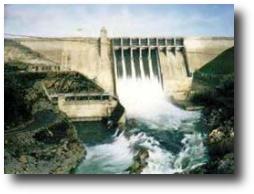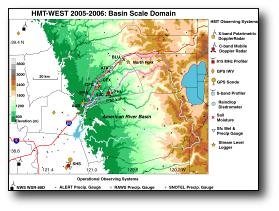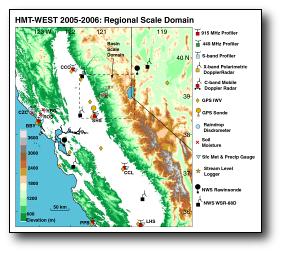NOAA Hydrometeorology Testbed
HMT-West: 2006 Operations
Participants
- NOAA Earth System Research Laboratories
(Physical Sciences Laboratory and Global Systems Laboratory) - NOAA National Severe Storms Laboratory
- NOAA Office of Hydrologic Development
- NOAA National Centers for Environmental Prediction
- NOAA National Weather Service - Western Region
- NOAA California-Nevada River Forecast Center
- CIRES - University of Colorado
- CIMMS - University of Oklahoma
- North Carolina State University
- Scripps Institute
- U.S. Geological Survey
- Western Regional Climate Center
Background
NOAA's Hydrometeorology Testbed (HMT) is a demonstration program that focuses the use of advanced observational and modeling tools on quantitative precipitation estimation (QPE) and quantitative precipitation forecasting (QPF) for the purpose of improving hydrologic forecasts and warnings. The testbed approach will accelerate transitions from the research and development community to operations, as described in NOAA's Strategic Plan and recommended by the NOAA Hydrology Team's Science and Technology Infusion Plan (STIP) and the U.S. Weather Research Program (USWRP).
Preliminary work for HMT was mostly conducted in the coastal mountains of California and Oregon (HMT-2004, HMT-2005). In the winter of 2005-2006, however, the primary emphasis shifts inland to the western slopes of the much taller Sierra Nevada. Intensive operations will be focused on the North Fork of the American River Basin between Sacramento and Reno. Water from the American River Basin is a critical resource for California's economy and natural habitats, and the threat of flooding poses an extremely serious concern for the heavily populated downstream area (Figure 1). The frequent impact of prolonged, heavy winter precipitation from concentrated "atmospheric rivers" of moisture, originating in the tropical Pacific, underscores the area's flood vulnerability.
HMT-2006 Field Operations
Figure 2 shows the locations of instruments in the American River Basin area for HMT-West-2006. Most will operate from December 2005 through March 2006. Transportable and mobile NOAA scanning precipitation radars (polarimetric and Doppler) will be deployed to complement and fill gaps in the operational network. Additional remote sensors to be deployed include wind profiling radars, precipitation profiling radars, and GPS sensors for measuring precipitable water vapor. Precipitation gauges, raindrop disdrometers, surface meteorological stations, soil moisture/temperature probes and stream level loggers will operate within the coverage areas of the scanning radars. Radiosondes will be released serially upwind of the area during storm episodes.
These special, highly detailed observations will be conducted within the wider scale context of the operational observing networks of the National Weather Service and other agencies (Figure 3). Ongoing observations in the Russian River watershed of California's Coast Range for NOAA's Weather-Climate Connection project will complement the HMT measurements. Similar or expanded HMT deployments are expected in the same area for each of the following few winters. Table 1 lists the instrument types and their location coordinates.
Data from HMT and operational sources will be merged in algorithms that produce multi-sensor (e.g., radar + gauge + satellite) estimations of precipitation. These blended estimates overcome deficiencies inherent in estimates based on single instrument types. Demonstrations and evaluations of precipitation forecast improvements will be conducted for the American River Basin using high-resolution numerical prediction models, now in use as research tools.
In addition to the ongoing evaluation of the practical usefulness of the various new observing and model tools, specific HMT 2005-06 research objectives include:
- Attaining accurate QPE over the basin with high spatial resolution.
- Demonstrate new high-resolution forecast models tailored to the HMT area.
- Accurately mapping the height of the melting layer and monitoring its evolution.
- Improving the understanding of orographically influenced winter storm airflow and precipitation development processes.
- Demonstrate the concept of a regional HMT as a conduit to infuse new science and technology into operations.
- Test and evaluate different precipitation measurement devices for use in future HMT efforts that will deal with mixed precipitation.
- Conduct water isotope measurements to study precipitation development processes.


